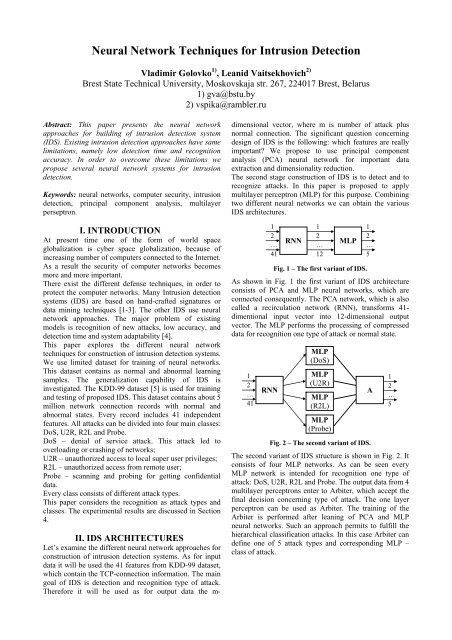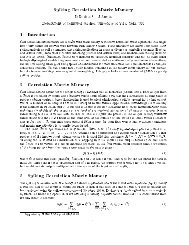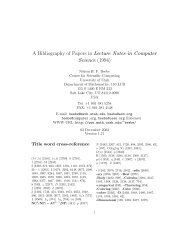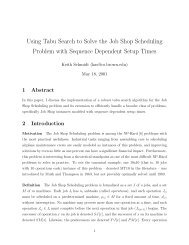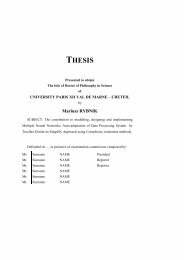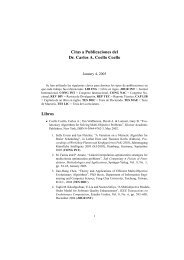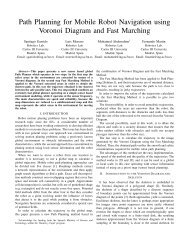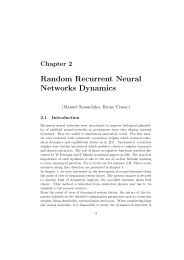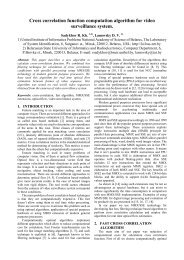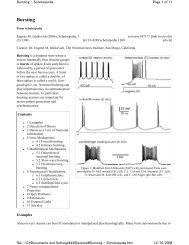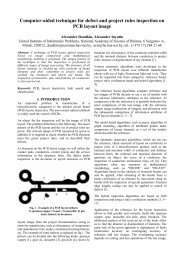Neural Network Techniques for Intrusion Detection - BSTU ...
Neural Network Techniques for Intrusion Detection - BSTU ...
Neural Network Techniques for Intrusion Detection - BSTU ...
You also want an ePaper? Increase the reach of your titles
YUMPU automatically turns print PDFs into web optimized ePapers that Google loves.
<strong>Neural</strong> <strong>Network</strong> <strong>Techniques</strong> <strong>for</strong> <strong>Intrusion</strong> <strong>Detection</strong><br />
Vladimir Golovko 1) , Leanid Vaitsekhovich 2)<br />
Brest State Technical University, Moskovskaja str. 267, 224017 Brest, Belarus<br />
1) gva@bstu.by<br />
2) vspika@rambler.ru<br />
Abstract: This paper presents the neural network<br />
approaches <strong>for</strong> building of intrusion detection system<br />
(IDS). Existing intrusion detection approaches have same<br />
limitations, namely low detection time and recognition<br />
accuracy. In order to overcome these limitations we<br />
propose several neural network systems <strong>for</strong> intrusion<br />
detection.<br />
Keywords: neural networks, computer security, intrusion<br />
detection, principal component analysis, multilayer<br />
perseptron.<br />
I. INTRODUCTION<br />
At present time one of the <strong>for</strong>m of world space<br />
globalization is cyber space globalization, because of<br />
increasing number of computers connected to the Internet.<br />
As a result the security of computer networks becomes<br />
more and more important.<br />
There exist the different defense techniques, in order to<br />
protect the computer networks. Many <strong>Intrusion</strong> detection<br />
systems (IDS) are based on hand-crafted signatures or<br />
data mining techniques [1-3]. The other IDS use neural<br />
network approaches. The major problem of existing<br />
models is recognition of new attacks, low accuracy, and<br />
detection time and system adaptability [4].<br />
This paper explores the different neural network<br />
techniques <strong>for</strong> construction of intrusion detection systems.<br />
We use limited dataset <strong>for</strong> training of neural networks.<br />
This dataset contains as normal and abnormal learning<br />
samples. The generalization capability of IDS is<br />
investigated. The KDD-99 dataset [5] is used <strong>for</strong> training<br />
and testing of proposed IDS. This dataset contains about 5<br />
million network connection records with normal and<br />
abnormal states. Every record includes 41 independent<br />
features. All attacks can be divided into four main classes:<br />
DoS, U2R, R2L and Probe.<br />
DoS – denial of service attack. This attack led to<br />
overloading or crashing of networks;<br />
U2R – unauthorized access to local super user privileges;<br />
R2L – unauthorized access from remote user;<br />
Probe – scanning and probing <strong>for</strong> getting confidential<br />
data.<br />
Every class consists of different attack types.<br />
This paper considers the recognition as attack types and<br />
classes. The experimental results are discussed in Section<br />
4.<br />
II. IDS ARCHITECTURES<br />
Let’s examine the different neural network approaches <strong>for</strong><br />
construction of intrusion detection systems. As <strong>for</strong> input<br />
data it will be used the 41 features from KDD-99 dataset,<br />
which contain the TCP-connection in<strong>for</strong>mation. The main<br />
goal of IDS is detection and recognition type of attack.<br />
There<strong>for</strong>e it will be used as <strong>for</strong> output data the m-<br />
dimensional vector, where m is number of attack plus<br />
normal connection. The significant question concerning<br />
design of IDS is the following: which features are really<br />
important? We propose to use principal component<br />
analysis (PCA) neural network <strong>for</strong> important data<br />
extraction and dimensionality reduction.<br />
The second stage construction of IDS is to detect and to<br />
recognize attacks. In this paper is proposed to apply<br />
multilayer perceptron (MLP) <strong>for</strong> this purpose. Combining<br />
two different neural networks we can obtain the various<br />
IDS architectures.<br />
1<br />
2<br />
…<br />
41<br />
RNN<br />
1<br />
2<br />
…<br />
12<br />
MLP<br />
Fig. 1 – The first variant of IDS.<br />
1<br />
2<br />
…<br />
5<br />
As shown in Fig. 1 the first variant of IDS architecture<br />
consists of PCA and MLP neural networks, which are<br />
connected consequently. The PCA network, which is also<br />
called a recirculation network (RNN), trans<strong>for</strong>ms 41dimentional<br />
input vector into 12-dimensional output<br />
vector. The MLP per<strong>for</strong>ms the processing of compressed<br />
data <strong>for</strong> recognition one type of attack or normal state.<br />
1<br />
2<br />
…<br />
41<br />
MLP<br />
(DoS)<br />
MLP<br />
(U2R)<br />
RNN<br />
MLP<br />
(R2L)<br />
A<br />
MLP<br />
(Probe)<br />
Fig. 2 – The second variant of IDS.<br />
1<br />
2<br />
…<br />
5<br />
The second variant of IDS structure is shown in Fig. 2. It<br />
consists of four MLP networks. As can be seen every<br />
MLP network is intended <strong>for</strong> recognition one type of<br />
attack: DoS, U2R, R2L and Probe. The output data from 4<br />
multilayer perceptrons enter to Arbiter, which accept the<br />
final decision concerning type of attack. The one layer<br />
perceptron can be used as Arbiter. The training of the<br />
Arbiter is per<strong>for</strong>med after leaning of PCA and MLP<br />
neural networks. Such an approach permits to fulfill the<br />
hierarchical classification attacks. In this case Arbiter can<br />
define one of 5 attack types and corresponding MLP –<br />
class of attack.
1<br />
2<br />
…<br />
41<br />
1<br />
2<br />
…<br />
41<br />
Fig. 3 – The third variant of IDS.<br />
Fig. 4 – The <strong>for</strong>th variant of IDS.<br />
The next variants of IDS structure are shown in the Fig. 3,<br />
4. As can be seen from the Figures, the initial 41dimensional<br />
vector here is divided on 3 parts, each of<br />
these contain the homogeneous data. Every PCA network<br />
is intended <strong>for</strong> processing of corresponding subvector.<br />
The MLP defines the type of attack and Arbiter accepts<br />
the final decision. Main difference between these two<br />
models is common MLP module in the variant 4.<br />
III. NEURAL NETWORKS<br />
As it is mentioned above we use PCA and MLP neural<br />
networks in order to construct IDS.<br />
x1<br />
x2<br />
x41<br />
2<br />
.<br />
.<br />
.<br />
41<br />
RNN<br />
RNN<br />
RNN<br />
RNN<br />
RNN<br />
RNN<br />
Fig. 5 – RNN architecture.<br />
Let’s consider an autoencoder, which is also called a<br />
recirculation network is shown in Fig. 5. It is represented<br />
by multilayer perceptron, which per<strong>for</strong>ms the linear<br />
compression of the dataset through a bottleneck in the<br />
hidden layer. As can be seen the nodes are partitioned in<br />
three layers. The hidden units per<strong>for</strong>m the compression of<br />
the input dataset. The j-th hidden unit output is given by<br />
41<br />
y j = ∑<br />
i=<br />
1<br />
w<br />
ij<br />
MLP<br />
X i<br />
j<br />
wij w' ji<br />
1<br />
1<br />
1<br />
Y i X<br />
2<br />
.<br />
.<br />
.<br />
12<br />
MLP<br />
MLP<br />
MLP<br />
2<br />
.<br />
.<br />
.<br />
41<br />
1<br />
2<br />
…<br />
5<br />
⋅xi<br />
, (1)<br />
where wij is the weight from the i-th unit to the hidden j-th<br />
unit.<br />
The output units are meant <strong>for</strong> decompression of the<br />
hidden dataset. The i-th output unit is given by<br />
x1<br />
A<br />
x2<br />
x41<br />
1<br />
2<br />
…<br />
5<br />
12<br />
xi = ∑<br />
j = 1<br />
w<br />
' ji⋅y<br />
j . (2)<br />
The weights of this network are updated iteratively in<br />
accordance with the Oja rule:<br />
w' ji ( t + 1)<br />
= w'<br />
ji ( t)<br />
+ α ⋅ y j ⋅(<br />
xi<br />
− xi<br />
) , (3)<br />
w w ' = . (4)<br />
ij<br />
As it is known [6] such a RNN per<strong>for</strong>ms a linear<br />
dimensionality reduction. In this procedure the input<br />
space is rotated in such a way that the output values are so<br />
uncorrelated as possible and the energy or variances of<br />
the data is mainly concentrated in a few first principal<br />
components.<br />
The preprocessing of input data is per<strong>for</strong>med be<strong>for</strong>e<br />
entering it to RNN:<br />
where<br />
x<br />
k<br />
i<br />
k<br />
ji<br />
xi<br />
− μ(<br />
xi<br />
)<br />
= k , (5)<br />
σ ( x )<br />
i<br />
L<br />
∑<br />
k = 1<br />
1 k<br />
μ ( xi<br />
) = xi<br />
, (6)<br />
L<br />
L<br />
∑<br />
k = 1<br />
k 1 k<br />
2<br />
σ ( xi<br />
) = ( xi<br />
− μ(<br />
xi<br />
)) . (7)<br />
L<br />
Here L is the number of training samples. The KDD-99<br />
dataset is used <strong>for</strong> RNN training. The mean square error<br />
makes 0.01. The training set contains 20% samples.<br />
Let’s consider the mapping of input space data <strong>for</strong> normal<br />
state and Neptune type of attack on the plane two<br />
principal components. As can be seen from the Fig. 6 the<br />
data, which belong one type of attack can be located in<br />
different areas. As a result is not possible the<br />
classification of such a data using only linear RNN<br />
because of complex relationships between features. One<br />
way to decide this problem is to use the nonlinear PCA<br />
network.<br />
Y2 coordinate<br />
Service auth (normal - 220; Neptune - 108)<br />
5<br />
4<br />
3<br />
normal Neptune<br />
2<br />
1<br />
0<br />
-2 -1 0 1 2 3<br />
-1<br />
Y 1 coordinate<br />
Fig. 6 – Data processed with RNN (service auth).
x1<br />
x2<br />
x12<br />
wki ij<br />
1<br />
1<br />
1<br />
w<br />
X k Yi j<br />
2<br />
.<br />
.<br />
.<br />
12<br />
2<br />
.<br />
.<br />
.<br />
10<br />
2<br />
.<br />
.<br />
.<br />
m<br />
Fig. 7 – MLP architecture.<br />
As it is mentioned be<strong>for</strong>e the MLP is intended <strong>for</strong> attack<br />
classification on the basis of principal components (Fig.<br />
7). The number of output units depends on determination<br />
of type or class attack. The backpropagation algorithm is<br />
used <strong>for</strong> training MLP. The mean square error makes<br />
0.01. After training of neural networks they are combined<br />
in an intrusion detection system.<br />
IV. EXPERIMENTAL RESULTS<br />
In this paper the KDD-99 dataset is used <strong>for</strong> training and<br />
testing different neural network models. The experiments<br />
were per<strong>for</strong>med separately <strong>for</strong> each service. The learning<br />
models were trained with 20% selections from datasets<br />
<strong>for</strong> each service. After training the neural networks have<br />
ability to intrusion detection. Some evaluation metrics<br />
were calculated during the testing process such as<br />
detection and recognition rates, true attack alarms, false<br />
attack alarms, etc.<br />
Let’s examine the recognition of attacks with the Model 1<br />
(see Section 2). Table 1 shows statistics of recognition<br />
attacks <strong>for</strong> some services depending on attack class. Total<br />
data <strong>for</strong> almost 30 services are given in Table 2.<br />
Table 2. Identification and recognition statistics depending<br />
on attack class <strong>for</strong> the Model 1 (almost 30 services)<br />
class count detected recognized<br />
DoS 286369 286334(99,9%) 286087(99,9%)<br />
U2R 49 41(83,7%) 40(97,6%)<br />
R2L 1119 1000(89,4%) 906(90,6%)<br />
Probe 1320 1312(99,4%) 1308(99,7%)<br />
normal state<br />
normal 83281 --- 82943(99,6%)<br />
From the above results, the best detection and recognition<br />
rates were achieved <strong>for</strong> DoS and Probe connections. U2R<br />
and R2L attack instances were detected slightly worse<br />
(83.7% and 89.4% respectively). Besides, the bottom row<br />
shows that some normal instances were (incorrectly)<br />
classified as intrusions.<br />
Next results (Table 3, 4) are associated with testing in the<br />
mode of attack type recognition. Experiments were<br />
per<strong>for</strong>med with different number of output neurons. The<br />
first case is 23 output units that represent every type of<br />
attack and a normal state. The second case is when the<br />
number of output units is varied dynamically. It means<br />
that the program automatically calculates a number of<br />
different states of network connections depending on their<br />
count in the training set.<br />
Y<br />
y1<br />
y2<br />
ym<br />
Table 3. Identification and recognition statistics<br />
depending on attack type <strong>for</strong> the Model 1 (dynamic<br />
count of output units)<br />
service<br />
true attack<br />
alarms<br />
false attack<br />
alarms<br />
recognized<br />
correctly<br />
auth 108(100%) 0 108(100%)<br />
domain 113(100%) 0 113(100%)<br />
eco_I 1252(99,9%) 7(1,8%) 1238(98,9%)<br />
ecr_I 281033(99,9%) 12(3,4%) 281033(100%)<br />
finger 202(100%) 11(2,3%) 200(99,0%)<br />
ftp 283(66,5%) 14(3,8%) 283(100%)<br />
ftp_data 864(93,7%) 44(1,2%) 777(89,9%)<br />
http 2399(99,7%) 96(0,16%) 2396(99,9%)<br />
IRC 1(100%) 1(2,38%) 1(100%)<br />
pop_3 123(100%) 0 123(100%)<br />
smtp 123(97,7%) 44(0,4%) 121(98,4%)<br />
telnet 284(96,6%) 16(7,31%) 280(98,6%)<br />
Table 4. Identification and recognition statistics<br />
depending on attack type <strong>for</strong> the Model 1 (23 output<br />
units)<br />
service<br />
true attack<br />
alarms<br />
false attack<br />
alarms<br />
recognized<br />
correctly<br />
auth 108(100%) 0 108(100%)<br />
domain 113(100%) 0 113(100%)<br />
eco_I 1252(99,9%) 0 1239(99,0%)<br />
ecr_I 281034(99,9%) 13(3,77%) 281034(100%)<br />
finger 186(92,1%) 10(2,14%) 185(99,5%)<br />
ftp 418(98,3%) 26(6,97%) 418(100%)<br />
ftp_data 856(92,7%) 31(0,82%) 636(74,3%)<br />
http 2400(99,7%) 96(0,16%) 2400(100%)<br />
IRC 1(100%) 1(2,38%) 1(100%)<br />
pop_3 123(100%) 0 123(100%)<br />
smtp 122(97,6%) 35(0,36%) 119(97,5%)<br />
telnet 284(96,6%) 15(6,85%) 272(95,7%)<br />
The results of testing (see Table 3, Table 4) are very<br />
comparative between the two modes.<br />
It is interesting to discuss other models proposed in<br />
Section 2. In the case with the Model 4 parameters of<br />
input vector were partitioned into the tree groups of whole<br />
numbers, keys (0/1) and numbers taking values from the<br />
range [0..1]. Each group is processed with the<br />
corresponding RNN. The purpose of this is to increase<br />
algorithm accuracy owing to the fact that each RNN<br />
works with homogeneous data. Though the Model 4<br />
resulted in slightly lower detection rates <strong>for</strong> U2R and R2L<br />
in comparison with the Model 1, it is still quite sensitive<br />
to the widely distributed in the KDD-99 DoS attacks. The<br />
main advantage of the Model 4 is that it allows to reduce<br />
training time. Due to smaller number of links in the<br />
module, that calculates principal components, it needs<br />
less computational requirement during the training<br />
process.
Table 5. Identification and recognition statistics<br />
depending on attack class <strong>for</strong> the Model 4 (almost 30<br />
services)<br />
class count detected recognized<br />
DoS 286369 286369(100%) 286295(99,9%)<br />
U2R 49 33(67,3%) 32(97,0%)<br />
R2L 1119 442(39,5%) 427(96,6%)<br />
Probe 1320 1311(99,3%) 1288(98,2%)<br />
normal state<br />
normal 83281 --- 77673(93,2%)<br />
We found that there was often situation when detection<br />
rates <strong>for</strong> some attack classes were considerably lower than<br />
<strong>for</strong> others. It was necessary to repeat training process<br />
from the very beginning to achieve desired results. We<br />
have applied the Model 2 to solve the problem. The goal<br />
in using this neural network architecture is to be able to<br />
get more accurate result <strong>for</strong> definite attack class. It is also<br />
possible to retrain each module MLP taken separately<br />
after general training circle has taken place. Table 6<br />
summarizes the per<strong>for</strong>mance of this kind of neural<br />
network.<br />
Table 6. Identification and recognition statistics<br />
depending on attack class <strong>for</strong> the Model 2 (almost 30<br />
services)<br />
class count detected recognized<br />
DoS 286369 286032(99,9%) 286022(100%)<br />
U2R 49 41(83,7%) 37(90,2%)<br />
R2L 1119 1063 (95,0%) 1049(98,7%)<br />
Probe 1320 1306(98,9%) 1306(100%)<br />
normal state<br />
normal 83281 --- 83009(99,7%)<br />
Table 1. Detailed identification and recognition statistics depending on attack class <strong>for</strong> the Model 1<br />
service<br />
normal<br />
count recognized count<br />
DoS<br />
detected recognized count<br />
U2R<br />
detected recognized<br />
auth 220 220(100%) 108 108(100%) 108(100%)<br />
domain 3 3(100%) 112 112(100%) 112(100%)<br />
eco_I 389 387(99,5%)<br />
ecr_I 345 327(94,8%) 281049 281031<br />
(100%)<br />
281031<br />
(100%)<br />
finger 468 456(97,4%) 197 189(95,9%) 85(45,0%)<br />
ftp 373 359(96,2%) 104 104(100%) 104(100%) 3 3(100%) 3(100%)<br />
ftp_<br />
data<br />
3798 3752(98.8%) 170 168(98,8%) 26(15,5%) 12 12(100%) 11 (91,7%)<br />
http 61885 61787(99,8%)<br />
IRC 42 41(97,6%)<br />
pop_3 79 79(100%) 118 118(100%) 118(100%) 34 26(76,5%) 26(100%)<br />
smtp 9598 9472(98,7%) 120 120(100%) 120(100%)<br />
telnet 219 204(93,2%) 198 198(100%) 198(100%) 34 26(76,5%) 26(100%)<br />
Table 1. Detailed identification and recognition statistics depending on attack class <strong>for</strong> the Model 1<br />
(continuation)<br />
service<br />
auth<br />
count<br />
R2L<br />
detected recognized count<br />
Probe<br />
detected recognized<br />
domain 1 1(100%) 1(100%)<br />
eco_I 1253 1251(99,8%) 1251(100%)<br />
ecr_I 6 0(0,0%) 0(0,0%)<br />
finger 5 5(100%) 4(80,0%)<br />
ftp 313 245(78,3%) 244(99,6%) 5 5(100%) 5(100%)<br />
ftp_<br />
data<br />
733 683(93,2%) 595(87,1%) 8 8(100%) 7(87,5%)<br />
http 4 4(100%) 4(100%) 8 8(100%) 8(100%)<br />
IRC 1 1(100%) 1(100%)<br />
pop_3 5 5(100%) 5(100%)<br />
smtp 5 5(100%) 3(60,0%)<br />
telnet 57 56(98,2%) 53(94,6%) 5 5(100%) 5(100%)
V. CONCLUSION<br />
In this paper the neural network architectures <strong>for</strong> intrusion<br />
detection have been addressed. The propose approach is<br />
based on integration of the recirculation network and<br />
multilayer perceptron. The KDD-99 dataset was used <strong>for</strong><br />
experiments per<strong>for</strong>ming. Combining two different neural<br />
networks (RNN and MLP) it is possible to produce<br />
efficient per<strong>for</strong>mance in terms of detection and<br />
recognition attacks on computer networks. The main<br />
advantages of using neural network techniques are ability<br />
to recognize novel attack instances and quickness of<br />
work, what is especially important in real time mode.<br />
REFERENCES<br />
[1] E. Eskin. Anomaly detection over noisy data using<br />
learned probability distributions. In Proceedings of the<br />
Seventeenth International Conference on Machine<br />
Learning (ICML-2000), 2000<br />
[2] A. Ghosh and A. Schwartzbard. A study in using<br />
neural networks <strong>for</strong> anomaly and misuse detection. In<br />
Proceedings of the Eighth USENIX Security Symposium,<br />
1999<br />
[3] W. Lee, S. J. Stolfo and K. Mok. Data mining in work<br />
flow environments: Experiences in intrusion detection. In<br />
Proceedings of the 1999 Conference on Knowledge<br />
Discovery and Data Mining (KDD-99), 1999<br />
[4] E. Eskin, A. Arnold, M. Prerau, L. Portnoy, S. Stolfo.<br />
A Geometric Framework <strong>for</strong> Unsupervised Anomaly<br />
<strong>Detection</strong>: Detecting <strong>Intrusion</strong>s in Unlabeled Data, In D.<br />
Barbara and S. Jajodia (editors), Applications of Data<br />
Mining in Computer Security, Kluwer, 2002<br />
[5] 1999 KDD Cup Competition.<br />
http://kdd.ics.uci.edu/databases/kddcup99/kddcup99.html<br />
[6] E. Oja. Principal components, minor components and<br />
linear networks. <strong>Neural</strong> <strong>Network</strong>s, vol.5, pp.927-935,<br />
1992


